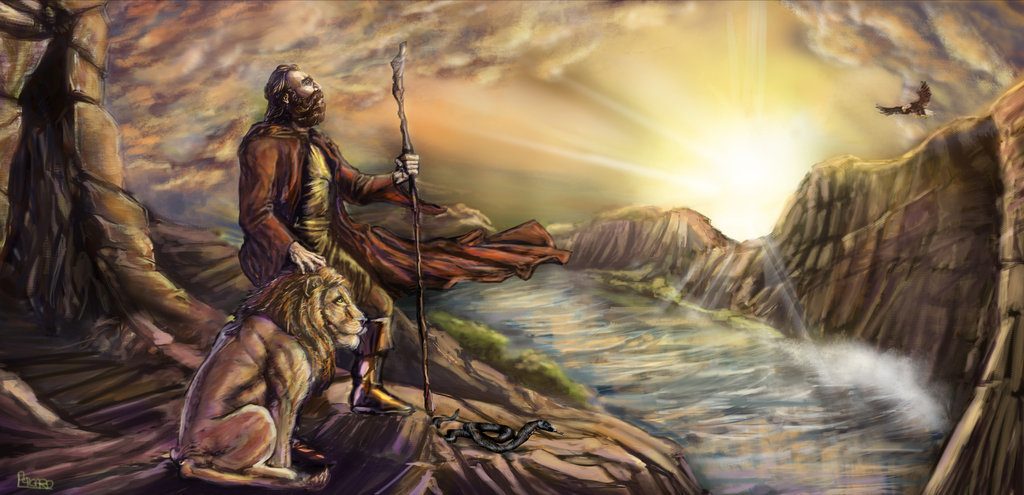Zoroastrianism was a dualist faith that originated in Persia, and over the years it has influenced a number of other faiths. Even though we may not recognize it today, it has been an influence on a number of world religions, especially on Christianity and Islam. Zoroastrianism is a belief system that stresses how we as human beings were meant to strive for our full potential. A primary tenet of the faith is that righteous and upstanding people will participate in the rewards of paradise, while the evil-doers will undergo punishments in hell.1
The prophet and founder of Zoroastrianism was Zarathustra, a man from an aristocratic family in Rhages, Media. Most scholars believe that Zarathustra was born around the late seventh and early sixth centuries B.C.E. He was a priest who became disillusioned with Persian ancestral religion, so instead he decided to search for inspiration and wisdom, and for a deeper meaning to life. After ten years of traveling, he finally realized that he had been called to be a prophet of Ahura Mazda, the Lord of Light. “He received a revelation in the form of the Avesta, the holy book of his religion, and commissioned to preach to humankind.”2 He would preach the Gathas; these were known as the hymns to the gods.
The central claim of Zoroastrianism is that there are two coequal and co-eternal gods: Ahura Mazda, the All-knowing Lord of Light, and Angra Mainyu or Ahriman, the Lord of Darkness. These gods represent an extreme dualism, where followers were given the option of choosing whom to worship. Ahura Mazda would save or condemn individuals based on whichever choice they decided to make.3 The people would experience rewards and punishments based on how they chose to behave. If they followed “Good words, Good thoughts, Good deeds,” they would be able to appreciate all the pleasures Ahura Mazda had in store for them in the afterlife.4

Devotees of Zoroastrianism believed that Ahura Mazda first produced the World of Thought and then gave birth to the World of the Living; but there was not yet life. Angra Mainyu challenged this pre-creation with his own counter-creation in order to destroy what Ahura Mazda was establishing. The Lord of Darkness wanted to demolish it with darkness, sickness, and death. Before Angra Mainyu was able to attack, Ahura Mazda forced him to recoil to the darkness. He was stunned into unconsciousness for three thousand years.5
Ahura Mazda then prepared for the Mixture of war, or battles against evil. This war was going to last six thousand years. For the first three thousand years, Ahura Mazda would unite with other lesser gods so that they could form a broad alliance. Angra Mainyu’s evil queen helped awaken the evil-doer and stirred all evil beings to attack Ahura Mazda. The battle then began, and Ahura Mazda’s creation came to life. Unfortunately, the very first beings killed were good, Gayomard and the Lone Bull; but from their semen they were able to manifest all humankind and bring into being all animals. Ahura Mazda’s right-hand man was Karsasp, a beautiful and innocent man, who helped fight off Angra Mainyu and his servants. Ahura Mazda then put Karsasp into a deep sleep so he would be well-rested for the very Last Battle.6 “At death, according to the tenets of Zoroastrianism, the souls of all persons ascend to the summit of Mount Hara where the good and bad of each soul are weighed in balances.”7 If one has made exceptional choices, ones soul will cross the cosmic bridge and continue an existence in heaven. In the case that many of one’s decisions were unacceptable, the bridge will disrupt and one’s soul will perish in hell. Scholar Charles David Isbell summarizes the eschatology of Zoroastrianism this way: “Since evil will have become extinct, history will come to an end, good souls will receive immortal bodies and will live forever in the re-perfected earth ruled over by Ahura-mazda.”8
This religion has continued to be practiced for as much as three thousand years. There are still a few thousand devotees that continue to carry on the traditions of Zoroastrianism in Iran and in India today. This religion has faced many difficulties in its long history, especially during the seventh century C.E. when invading Arab Muslims conquered the land of Persia, the homeland of Zoroastrianism. The conquerors chose not to take away this religion altogether, but they did choose to put a financial burden on the Zoroastrian temples.9 Many fled to India, which is home today to many of their descendants, known as Parsis. Many of those who stayed in Persia ended up converting to Islam. Although it may not be practiced as widely today, it has made a considerable impact on other religions.
Christianity was one of those religions that may have been influenced by elements within Zoroastrianism. Scholar John R. Hinnells writes,
It is generally held that the form of the later Jewish and Christian concept of the devil or Satan was influenced by Iranian tradition. If this be accepted then it has serious implications for the understanding of the saviour or Messianic figure…. When [the devil] becomes truly demonic … then the savior is given a new task.10
That task, Hinnells believes, was to defeat a supernatural and evil being, which taps into Zoroastrian dualism. In fact, the beliefs in a Satan of evil pitted against a God of good, the belief in angels and demons fighting a cosmic war, and the belief in a savior figure who would save all of humanity from evil and sin are all elements deriving from Zoroastrianism.11 Zoroastrianism in its original form may be an obscure faith in today’s society, but its impact on the fundamental principles of many religions is evident and deserves our appreciation and acknowledgement.
- Jerry Bentley, Herbert Ziegler, Heather Streets Salter, Traditions & Encounters: A Brief Global History Volume 1 (New York, NY: McGraw-Hill Publishers, 2016), 95-99. ↵
- Salem Press Biographical Encyclopedia, 2015, s.v. “Zoroaster,” by J. Steward Alverson. ↵
- Funk & Wagnalls New World Encyclopedia, 2016, s.v. “Ahura Mazda.” ↵
- Bentley, Ziegler, and Street Salter, Traditions & Encounters, 96-97. ↵
- P. Oktor Skjærvø, “Good vs. Evil,” Calliope 15, no. 5 (January 2005): 8. ↵
- P. Oktor Skjærvø, “Good vs. Evil,” Calliope 15, no. 5 (January 2005): 8. ↵
- Charles David Isbell, “Zoroastrianism and Biblical Religion,” Jewish Bible Quarterly (2006). ↵
- Charles David Isbell, “Zoroastrianism and Biblical Religion,” Jewish Bible Quarterly (2006). ↵
- Bentley, Ziegler, and Street Salter, Traditions & Encounters, 97-98. ↵
- John R. Hinnells, Zoroastrian and Parsi Studies: Selected Works of Johr R. Hinnells (Burlington, VT: Ashgate Publishing Co., 2000), 46. ↵
- Bryan Rennie, “Zoroastrianism: The Iranian Roots of Christianity,” The Council of Societies for the Study of Religion vol. 36 no. 1 (2007): 3-5. ↵



89 comments
Edward Cerna
This was a really interesting article. I am currently learning about this in class and had to read this for a reading and I am glad he assigned it. It was well organized and it really just flowed. I do think Christianity may have been influenced by this. The war between good and evil and a paradise and hell.
Evelin Joseph
We are learning about Persia and Zoroastrianism in class right now, so gaining more knowledge on the subject through this article was great! It was eye-opening to see all the similarities found in this religion and religions of today such as Christianity and Islam. I am glad that I got to learn more about Ahura Mazda, the All-knowing Lord of Light, or their God of Good and Ahriman, the Lord of Darkness or their God of Evil. I was also surprised to learn about the creation of humankind in this religion, which came about through the semen of Gayomard and the Lone Bull.
Rebekah Esquivel
I had never heard of Zoroastrianism before and this was a very informative article to read about it. I found the creation story part of this article very interesting, it helped to give a base to what the belief system is and how the whole thing came about. I also found it very interesting that the first two people killed were said to be good people. That is a little odd considering good people should have no reason to be killed. I would really like to know why this religion has died off or is not really spoken of today.
Alexis Renteria
I had read about Zoroastrianism before but I had a hard time understanding what the writer was saying. However, this article gave me a better understanding of where Zoroastrianism came from and its practices. I also had no idea that the whole ” good vs evil” that we always hear in Christianity came from Zoroastrianism. Overall this was a very interesting article, and I am glad I came across it because I probably would have never learned about this religion if I hadn’t.
Alexandria Martinez
This was a very interesting article, and to be honest I had never heard about this until today. It is always nice to learn about new things and become more educated. It is also interesting to hear that this influenced the Jew and Christian faiths. I know religions all pretty much build off of each other but it is still nice to learn how a certain practice/religion influenced the religions of today.
Lisa Varela
Before this article I knew nothing of Zoroastrianism. Thus, this article was very helpful and informative. Great article! I was surprised to learn that Zoroastrianism influenced Christianity and Islam. The history behind Zoroastrianism is something that I feel happens too often with other religions. It is impressive that Zoroastrianism has survived as this years, even after its history. I agree with the last statement of the article, “… but its impact on the fundamental principles of many religions is evident and deserves our appreciation and acknowledgement.”
Alexis Soto
I can say I am now more knowledgeable on the Zoroastrian religion. As a history major I have often come across Zoroastrian when discussing Ancient Civilizations. I had an idea of what it was and how it came to influence Christianity and Islam, however I did not know of the origins and the duality of light and dark. Overall an informative article.
Andrea Chavez
I have to say this article did catch me in the first two paragraphs. This is a topic very interesting for me because it does not only involve history but religion too. I find very interesting how we can relate certain things that now a days are so important, with things that have been there for thousands of years. The battle of good and evil will always lead to good, intense discussions, in my opinion. It’s interesting to know the forms of religion that people practiced in the old days and how it has changed and evolved over the years.
Mario Sosa
This article was fascinating, as I have never heard of Zoroastrianism before. I am curious as to why this religion never really expanded in followers as it has existed since around seventh century BC. Another thing that I wonder is why the Parsis that now reside in India never returned to Persia to practice their religion. This was an excellent article to read, superb job!
Hayden Hollinger
Before reading this article, I wasn’t sure if I was going to enjoy it but I was wrong. This was a very interesting topic that I had no prior knowledge of so I was glad to learn about something new. This was clearly a well researched article and it was good to see you used a variety of sources. I found it very interesting that Zoroastrianism has influenced many other faiths.